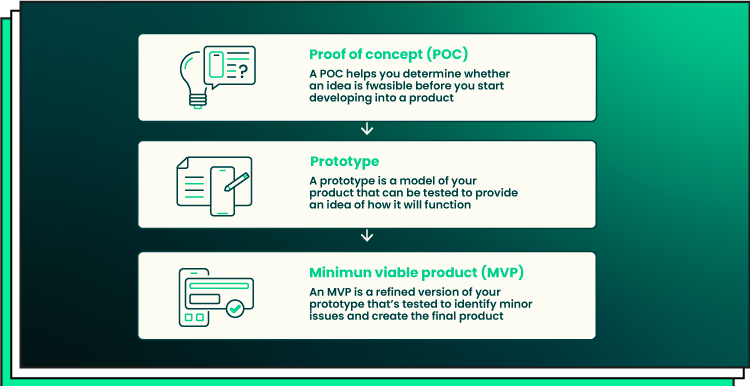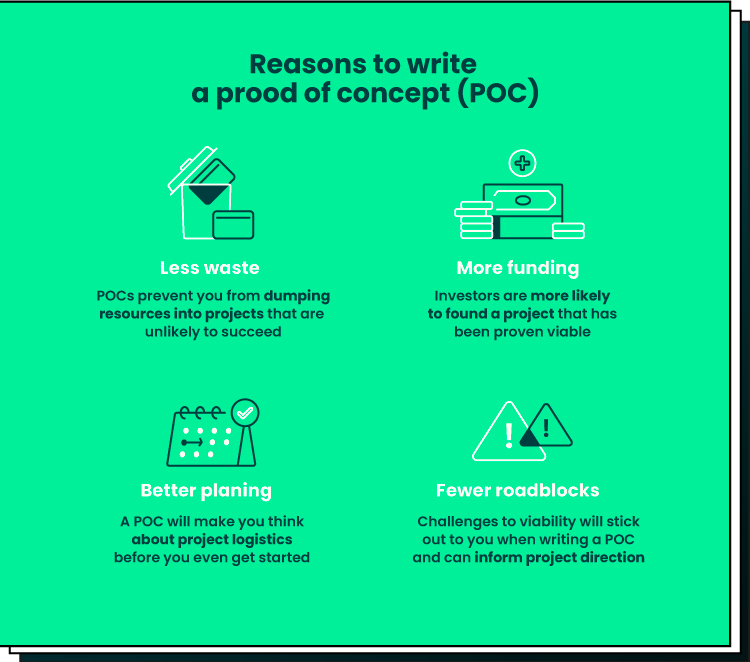In the dynamic world of software development where innovation and ideas can make or break a product, it is crucial to validate your software idea before committing substantial resources. One powerful tool and methodology that can help you achieve this is the Proof of Concept (POC). In this article, we will delve into the significance of POC in software development and explore its benefits, key elements, and best practices for conducting a successful POC.
What is a proof of concept? Before we delve into the underlying principles of POC, let’s first explore the benefits it offers to startup owners and IT entrepreneurs.
- Avoid wasted resources. POCs help you avoid investing in unnecessary, poorly planned, or unwanted projects that fail to meet customer needs. Test your software idea early on to ensure it’s worth pursuing.
- Mitigate risks. POCs allow you to identify and address potential challenges and pitfalls upfront, reducing the risk of failure in later stages.
- Gain valuable insights. Through POCs, you can gather insights and learnings about your software or product. Test key metrics, understand user response, and refine your project ideas based on real data to make informed decisions.
- Attract stakeholders. What does POC stand for in business? Presenting a successful proof of concept gives you tangible proof of your idea’s potential. Gain the confidence and support of investors and decision-makers by showcasing a functional prototype or experiment.
- Stay ahead of competitors. POCs give you a competitive advantage. With its help, you can not only validate your software idea but also differentiate yourself from competitors.
What is POC in software development? A Proof of Concept is widely regarded as the most effective approach to validate an initial IT product idea and assess its feasibility for practical implementation.
In this article, we will learn the importance of POC for your upcoming product and uncover the key stages involved in this process. If you need practical and immediate assistance in validating your software ideas, reach out to our experienced project managers and skilled IT engineers for a complimentary consultation. Our team can provide valuable insights and help you approve your concept efficiently. Don’t hesitate to get in touch today.
Understanding Proof of Concept (POC): What is POC?
Before we delve further into the realm of POC in software development, let’s establish a clear understanding of its significance in the context of modern IT startup practices and culture. In software development, a proof of concept (POC) refers to a preliminary project or prototype of a small scale that aims to showcase the feasibility and potential of a software idea. It acts as a valuable tool to validate assumptions, assess technical feasibility, and gather critical insights before committing to a full-scale development process.
Now, the question arises: is a POC necessary for every project? While it may be considered optional, embracing a POC stage can unlock a plethora of new opportunities that hold immense importance in today’s dynamic landscape. These opportunities arise from addressing various challenges and scenarios that include:
- Security threats. By conducting a POC, you can identify and mitigate potential security threats early on. This ensures that your software solution is robust, safeguarding sensitive data and user privacy.
- Innovative features. POCs provide a platform to experiment and explore innovative features. By proof of concept testing of these features in a controlled environment, you can evaluate their effectiveness and gather user feedback, helping you refine your product offering.
- Challenging market offerings. POCs enable you to test the market viability of your software idea. By gauging customer interest and demand through a proof of concept, you can make informed decisions about pursuing a specific market offering or pivoting to better align with customer needs.
- Project complexity. Complex projects often involve multiple dependencies and intricate technical requirements. Conducting a POC allows you to assess the feasibility of implementing such complex functionalities and validate whether your team possesses the necessary skills and resources to deliver the desired outcome.
- Scarcity of skilled professionals: In today’s competitive tech landscape, finding qualified professionals can be a challenge. A POC provides an opportunity to evaluate the proficiency and capabilities of your team, ensuring that they possess the necessary skills to tackle the project successfully.
Hence, it becomes crucial to evaluate the viability of your solution before fully committing to a project. By investing time and effort in a well-executed POC, you can ensure that the costs and risks involved are proportional to the anticipated business results. Ultimately, a carefully crafted proof of concept empowers you to make informed decisions, minimize risks, and maximize the chances of developing a successful software solution. The simplest way to determine if your project requires a proof of concept (POC) is to assess the presence of an innovative element. The schema below outlines the key considerations:

What is Proof of Concept’s Distinction from MVP?
Sometimes, there is confusion between POC (Proof of Concept) and MVP (Minimum Viable Product). However, it’s essential to understand that these are two distinct concepts in software development, each serving a different purpose. Let’s explore how they differ:
Proof of Concept (POC):
A POC is a small-scale project or prototype that aims to demonstrate the feasibility and potential of a software idea. It is typically focused on validating specific technical aspects or assumptions of the concept. The main objective of a POC is to assess the viability and gather insights before committing to a full-scale development process. POCs are often exploratory in nature and can be used to test new technologies, features, or approaches. They help in mitigating risks, addressing technical challenges, and gaining stakeholder buy-in before proceeding with further development.
Minimum Viable Product (MVP):
An MVP, on the other hand, is an early version of a software product that contains the minimum set of features required to address the core problem or meet the target audience’s primary needs. The goal of an MVP is to deliver a usable product that can be released to the market and gather valuable user feedback. MVPs are designed to test assumptions, validate the product-market fit, and iterate based on user insights. The focus of an MVP is on delivering value to the users and obtaining real-world feedback to guide further development.


Why Do Technical Startups Require Building a POC?
POC (Proof of Concept) typically includes development and testing processes. However, they are usually conducted on a smaller scale compared to full-scale development. During the POC stage, developers create a basic version or prototype of the software idea to demonstrate its feasibility and potential. This involves writing code, implementing key functionalities, and conducting initial testing to validate the technical aspects of the concept.
Why is POC required? Here are the key points highlighting the importance of conducting a proof of concept (POC) in software development:
- A functional POC serves as evidence that your product can be developed successfully, providing confidence in its technical feasibility and paving the way for further development.
- It helps you determine the optimal development approach. During the POC phase, you have the opportunity to explore different development approaches and technologies.
- By experimenting with various options, you can identify the most suitable technology stack and development methodology for your project. This ensures that you choose the approach that aligns best with your requirements and maximizes the chances of success.
- POC provides an opportunity to refine your software development strategy. Through iterative testing and feedback, you can optimize features, user experience, and overall product offering, ensuring alignment with customer needs.
- It allows you to address technical hurdles, evaluate scalability, and make informed decisions based on real-world insights.
- Cost forecasts. By undertaking a proof of concept, you gain valuable insights into the anticipated expenses of the final project. This endeavor can reveal any hidden costs that may arise and also present opportunities to identify cost-saving measures once the main project is in progress.

Key Elements of a Successful POC
What is POC meaning in terms of associated jobs to be done? To ensure a successful POC, it is essential to focus on several key elements. By addressing these elements, you can increase the effectiveness of your POC software results and derive maximum value from the process. Here are the key elements to consider:
Clear Objectives: Establishing the Product Need
Establishing clear objectives is crucial when conducting a proof of concept (POC). It is essential to define what you aim to achieve through the POC, whether it is validating specific features, assessing technical feasibility, drawing the attention of investors, or gathering user feedback. Having clear objectives helps align the team’s efforts and provides a roadmap for executing the POC effectively.
Identifying Critical Features
During the POC, it is essential to identify the critical features or functionalities that require validation. These features should be the ones that set your software idea apart from existing solutions and are integral to its success. By focusing on these critical features, you ensure that the POC covers the essential aspects and provides meaningful insights. Select one to three features to develop and test, which will later make a foundation for your future MVP.
Gathering Tangible Evidence: Showcasing Market Pain Points
To secure investment for your project, it is vital to gather tangible evidence that showcases the pain points within your target market. Investors are more likely to support projects that address genuine needs and offer a clear value proposition. By engaging directly with potential customers, conducting surveys, or holding focus groups, you can collect valuable data that substantiates the existence and severity of the challenges they face.
Choosing Appropriate Evaluation Metrics
Selecting the right evaluation metrics is essential to measure the success of your POC. Determine the specific criteria you will use to assess the performance, user experience, scalability, or any other relevant factors. Well-defined metrics provide a quantifiable basis for evaluating the outcomes and enable objective decision-making.
Best Practices for Conducting a POC
To maximize the effectiveness of your POC, it is crucial to follow best practices throughout the process. By adopting these practices, you can streamline your POC execution and increase the likelihood of obtaining accurate and actionable results. Consider the following best practices when conducting a POC:
Selecting the Right Team
Assemble a team comprising professionals who possess the necessary expertise and skills to execute the POC effectively. It is crucial to ensure that team members have the required technical knowledge and a deep understanding of the business domain. Forbytes is here to assist you in shaping both the proof of concept and the future MVP, leveraging our expertise in software development. By building a diverse team that includes developers, testers, designers, and subject matter experts, you can benefit from varied perspectives and contribute to a comprehensive evaluation process.
Allocating Resources Effectively
Allocate resources judiciously during the POC phase. While it is essential to have sufficient resources to build a functional prototype, it is equally important to avoid overinvestment. Focus on the following post-POC phase which involves creating a minimum viable product (MVP) that can demonstrate the core value proposition of your software idea without unnecessary complexity.
Leveraging Agile Methodologies
The POC stage allows for an iterative approach, where you can continuously refine and enhance your software idea based on the insights, findings, observations, and feedback received. Adopting agile methodologies, such as iterative system development and frequent feedback cycles, can greatly benefit your POC. Breaking down the development process into manageable iterations allows for rapid prototyping, continuous improvement, and quicker validation of ideas. Agile practices also facilitate collaboration, adaptability, and the ability to respond to changing requirements.
Real-World Examples of Successful POCs
Numerous successful proof of concept examples have paved the way for groundbreaking software products. Let’s explore a couple of notable examples that highlight the impact of conducting POCs in the software industry:
Example 1: Airbnb
Before becoming the global accommodation phenomenon it is today, Airbnb started as a proof of concept. The founders initially created a simple website to validate the idea of people renting out their spare rooms or properties to travelers. The positive response and demand generated from this POC helped Airbnb secure further investments and develop into the disruptive platform it is now. By the way, if you require help with building a real-estate management platform, consider our expertise in this field.
Example 2: Slack
Slack, the widely popular team collaboration tool, began as an internal communication platform for a gaming company. The success of this internal POC led the team to recognize the broader market potential of their software. With further development and fine-tuning, Slack became one of the leading communication tools for teams worldwide.
These examples demonstrate how POCs can provide valuable insights and validate software ideas, leading to significant success in the market.
Conclusion: What Is a POC in Your Business?
In the dynamic landscape of software development, validating your software ideas before making substantial investments is paramount. Proof of concept (POC) emerges as a powerful ally in this pursuit. By harnessing the capabilities of data analytics, machine learning, and mobile app development, you can leverage the full potential of a POC. Through meticulous planning and execution, a POC enables you to minimize risks, assess feasibility, and glean invaluable insights into the viability of your software idea.
To make the most of a POC, it is essential to establish clear objectives, identify critical features, and define appropriate evaluation metrics. Leverage the expertise of Forbytes’ skilled team to assemble a group of specialists who possess the necessary technical knowledge and fin-tech, AR, and e-commerce domain expertise. With us, you can gain access to a diverse range of perspectives that will greatly contribute to the success of your POC and subsequent stages of software development.
Contact us today for deeper consulting.

Our Engineers
Can Help
Are you ready to discover all benefits of running a business in the digital era?

Our Engineers
Can Help
Are you ready to discover all benefits of running a business in the digital era?







